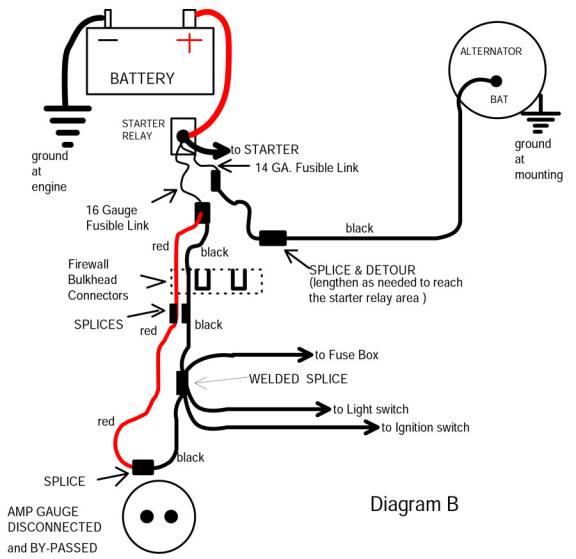It seemed like it would be a bad idea for those to touch
An ammeter is a series instrument just like a piece of wire. They already "touch" electrically. You have to understand what MAD is advocating there. Their method is sort of a "cheap fix." They are essentially modifying the system so that the black and red wire become a parallel circuit so that both act as a power feed into the car. The jumper added from the alternator to the battery connects the "engine end" of the red/ black together, just as jumpering the ammeter end does. Connecting the ammeter ends together and eliminating the ammeter, simply insures that the ammeter is not going to become part of a problem, and if it's been damaged like the one in the article, it already "is" part of the problem.
Look at the diagram from page two of the article:
http://www.madelectrical.com/electricaltech/amp-gauges2.shtml
You can follow from the ammeter where the black/ red have been connected, back through the bulkhead, and see that they have cut the old black wire and spliced it into the red. These two thus become "one wire" and that doubles the capacity of that feed.
Additionally, the black feed from the alternator is now DIVERTED directly back to the battery. This means that the alternator current no longer has to go clear through the bulkhead, through the ammeter, and back out on the red wire to the battery. We have eliminated several feet of wire, as well as two possible bad connections in the bulkhead connector.
THAT ALONE could be the cause of your low idle problem.
It's important to point out that scads, thousands of these cars and trucks were driven for their useful lives with no problems. But even "back then" some of us DID have problems, and now that these girls are 40+ years old, time has caused more deterioration. Back in the days of my 70 RR, both the original owner and myself were radio amateurs. It melted the bulkhead connector during that time, and way WAY back then, I just drilled out the connector and ran new wires through for the ammeter connections.
It is VERY important to chase down voltage drop problems before you invest a bunch of money into alternators/ regulators. It might just be "all" of the problem.

















